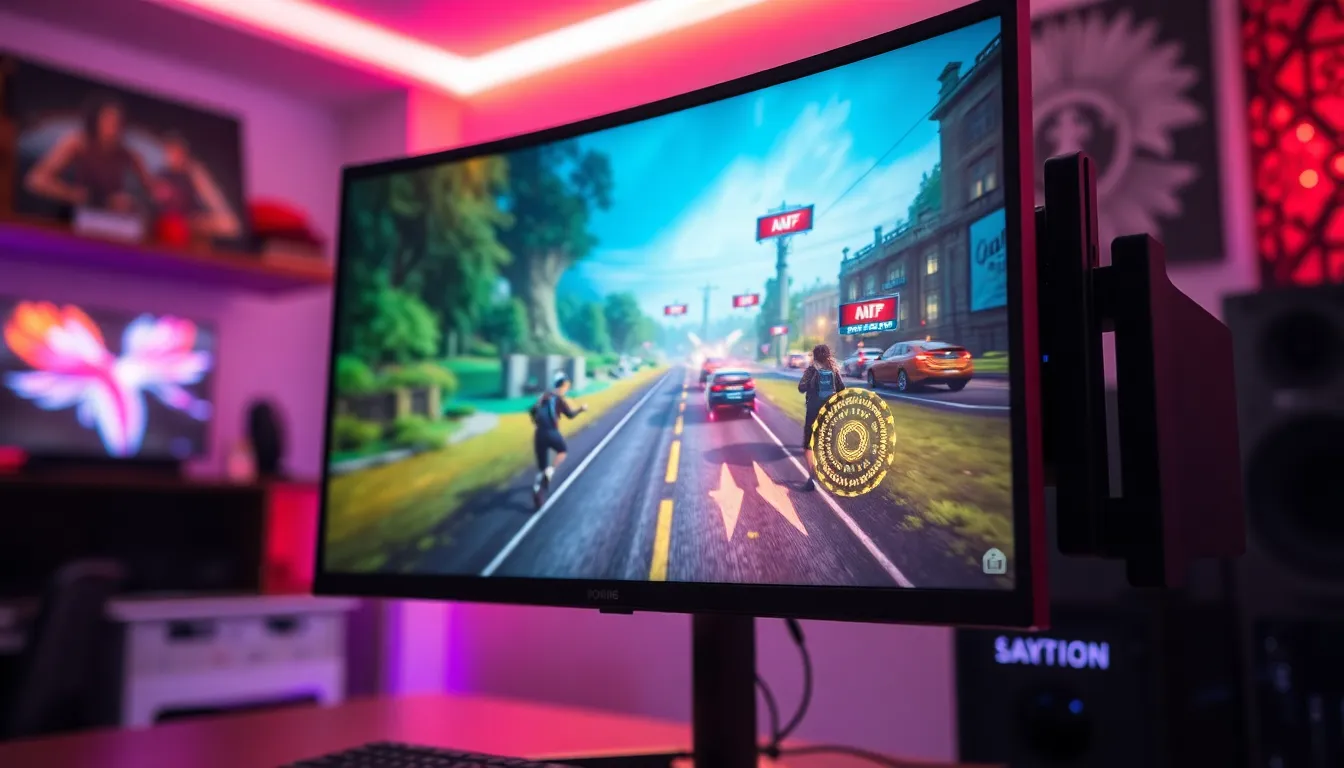In the fast-paced world of gaming and multimedia, frame pacing metrics are the unsung heroes that keep everything running smoothly. Imagine trying to enjoy a thrilling race, only to find your car stuttering like it’s stuck in traffic. That’s what poor frame pacing feels like! It’s time to dive into the nitty-gritty of these metrics and discover how they can transform a choppy experience into a buttery-smooth ride.
Understanding frame pacing isn’t just for tech nerds; it’s crucial for anyone who craves seamless visuals. Whether you’re a gamer, a content creator, or just someone who loves binge-watching your favorite shows, mastering frame pacing can elevate your experience to a whole new level. So buckle up as we explore the fascinating world of frame pacing metrics and learn how to ensure your visuals are as smooth as a freshly waxed surfboard.
Table of Contents
ToggleOverview of Frame Pacing Metrics
Frame pacing metrics measure the timing consistency of frames in video playback and gaming. These metrics assess how evenly frames render over time, impacting the overall visual experience. Variability in frame delivery leads to stuttering and tearing, which detracts from seamless graphics. Gamers and content creators recognize the importance of smooth playback for maintaining immersive experiences.
Frame time analysis involves calculating the time it takes to render each frame. Tools such as frame time graphs display this data, showing significant spikes or dips that indicate pacing issues. Lower average frame times represent better performance. Conversely, higher frame times indicate potential problems with rendering consistency.
Another metric, frame variance, highlights the difference between the shortest and longest frame times. A lower variance suggests stable performance, while a higher variance points to irregularities. Monitoring these fluctuations enables users to identify performance bottlenecks.
One common goal in gaming and multimedia is achieving a frame rate that matches the monitor’s refresh rate. This synchronization minimizes visual artifacts and enhances fluidity. Technologies like V-Sync and adaptive sync assist in maintaining this harmony.
Frame pacing can also benefit from tools that optimize rendering performance. Utilizing features such as triple buffering increases frame delivery consistency. Implementing these techniques leads to smoother gameplay and an improved viewing experience.
Understanding frame pacing metrics equips individuals with the knowledge necessary to optimize their visual performance. Acknowledging frame times, variances, and synchronization helps in creating a more enjoyable and immersive experience.
Importance of Frame Pacing Metrics

Frame pacing metrics play a crucial role in enhancing visual experiences by ensuring consistent performance. Smooth frame delivery leads to engaging gameplay and seamless multimedia playback.
Impact on User Experience
Inconsistencies in frame delivery can detract from user experience. Users often face stuttering and tearing when frame timing is irregular. An analysis of frame times reveals performance bottlenecks that cause these issues. Tools like frame time graphs help users pinpoint where to optimize performance. A stable frame rate creates a more enjoyable environment, allowing users to immerse themselves in their favorite games or videos.
Relevance in Gaming and Multimedia
Frame pacing metrics hold particular significance in gaming and multimedia scenarios. Gamers benefit from consistency because it enhances responsiveness and fluidity. In multimedia playback, smooth frame transitions contribute to engaging storytelling and immersive visuals. Devices like gaming monitors utilize refresh rates matched with frame rates to reduce visual artifacts. Content creators also rely on these metrics to ensure high-quality outputs.
Methods for Measuring Frame Pacing Metrics
Measuring frame pacing metrics involves utilizing various tools and adhering to best practices. Accurate analysis ensures a smooth visual performance in gaming and multimedia.
Tools and Software
Several tools provide valuable insights into frame pacing metrics. Software like FRAPS and MSI Afterburner captures frame times and displays frame rate statistics in real time. Additionally, tools like CapFrameX and NVIDIA FrameView offer in-depth analysis, allowing users to visualize frame time graphs for identifying inconsistencies. These applications support various gaming platforms, making them versatile options for users seeking to enhance their visual experiences. Each tool brings distinct features to accommodate different preferences and analysis needs.
Best Practices for Measurement
Applying best practices leads to effective measurement of frame pacing metrics. Users should conduct tests in consistent environments to obtain accurate data. Capturing frame times during actual gameplay scenarios yields more realistic results compared to synthetic benchmarks. Maintaining stable system performance is crucial; closing background applications minimizes disruptions. Taking multiple measurements and averaging them provides a clearer picture of performance consistency. Finally, comparing results against established standards aids users in identifying potential improvements in frame pacing.
Analyzing Frame Pacing Metrics
Understanding frame pacing metrics involves interpreting data results and addressing common issues for optimal performance.
Interpreting Data Results
Data results from frame pacing metrics provide crucial insights into frame timing and consistency. Observations of frame time graphs highlight areas where frame delivery varies significantly. When analyzing these graphs, sharp spikes in frame times can indicate potential stuttering issues. Averaging multiple measurements across different gameplay scenarios offers clearer insights into overall performance stability. Tools like MSI Afterburner and FRAPS excel at visualizing this data. Users can detect patterns in frame delivery, enabling them to identify specific bottlenecks affecting their experience.
Common Issues and Solutions
Several common issues arise during frame pacing analysis. Inconsistent frame delivery often results in noticeable stuttering. To combat this, users can synchronize monitor refresh rates with frame rates to minimize tearing. Another frequent issue involves system performance; high background processes can hinder frame delivery. Closing unnecessary applications frees system resources, allowing for smoother gameplay. Implementing optimization tools, such as triple buffering, enhances rendering performance. Regular testing in controlled environments ensures accurate data collection, further facilitating smoother experiences.
Future Trends in Frame Pacing Metrics
Emerging technologies continually shape frame pacing metrics, leading to advancements in gaming and multimedia experiences. One significant trend revolves around the integration of artificial intelligence in analysis tools. AI-driven software can predict frame delivery patterns, allowing users to optimize performance more effectively.
Another trend focuses on the rise of adaptive sync technologies like G-SYNC and FreeSync. These innovations sync frame rates with monitor refresh rates, reducing tearing and stuttering. Implementing these systems enhances visual fluidity, contributing to an overall seamless experience.
The expansion of cloud gaming also impacts frame pacing metrics. Users now face unique challenges regarding latency and network stability. Ensuring consistent frame delivery will become critical as more gamers transition to cloud platforms.
Virtual reality (VR) is set to alter frame pacing metrics significantly. As VR experiences demand higher frame rates for immersion, developers will prioritize stable frame delivery. Addressing performance issues will foster realistic and engaging environments for users.
In addition, developments in hardware play an essential role in advancing frame pacing metrics. Graphics cards with better performance capabilities allow for smoother frame delivery. With increased processing power, users can expect fewer instances of stutter or tearing.
Emerging technologies and evolving trends in frame pacing metrics offer a landscape of possibilities. These advancements empower gamers and content creators to achieve high-quality performance. By embracing innovations in analysis, adaptive syncing, and hardware, users enhance their overall visual experiences.
Mastering frame pacing metrics is essential for anyone looking to elevate their gaming or multimedia experience. By understanding the nuances of frame time analysis and utilizing the right tools, users can identify and address performance bottlenecks. This proactive approach not only minimizes stuttering and tearing but also ensures a seamless visual journey.
As technology continues to evolve with advancements in hardware and adaptive sync technologies, staying informed about frame pacing will be crucial. Embracing these metrics allows gamers and content creators alike to enjoy a more immersive experience, paving the way for future innovations in the realm of digital entertainment.




